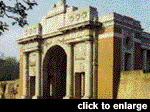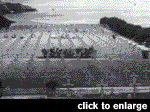





Land Forces Memorials |

|
|
 |
The Ypres (Menin Gate) Memorial (its official name) spans one of the two main gateways into the town. It was through the Menin Gate, a roadway flanked by two stone lions where the medieval gate once stood, that hundreds of thousands of Commonwealth soldiers passed on their way to the battlefields of the Ypres Salient. The memorial was designed by Reginald Blomfield and joins the two ends of Vauban's defensive ramparts (which did exist even though the gate itself did not) by means of a great arch spanning the road to Menin. The panels inside the 120 foot-long arch, the stairways and upper loggias, bear the names of 40,000 British (who died before 16th August 1917), 7,000 Canadian, 6,000 Australian, nearly 600 South African, and 400 Indian soldiers who died in the Salient and have no known grave. New Zealand decided that the names of its missing should be commemorated on various New Zealand memorials nearer to the place where the missing were presumed to have died. The memorial was considerably damaged during the fighting of spring 1940, but it has been repaired, less a few honourable scars. The regiments most represented are King's Royal Rifle Corps with 1,444 names for the United Kingdom; the Canadian Mounted Rifles with 721; the Australian Machine Gun Corps with 244; 1st Regiment South African Infantry with 166; and 57th Wilde's Rifles (Frontier Force) with 79 names for India. |
 |
The memorial was unveiled by Field Marshal Lord Plumer of Messines in the presence of King Albert I of the Belgians on 24th July 1927. It is perhaps the best known war memorial anywhere. The main road which runs under the arch is closed by the police every day at 2000 hours, when members of the local fire service sound Last Post. This has happened daily since 1929, except during the German occupation of 1940-1944, and is a ceremony which is still well attended by local people, but particularly by visitors and pilgrims. Back to the Top. |

The Alamein Memorial stands at the entrance to El Alamein War Cemetery and takes the form of a cloister 270 feet long. It commemorates nearly 9,000 soldiers of the Western Desert Forces and Eighth Army who died in the campaigns in Egypt and Libya, and in the operations in Tunisia up to 19th February 1943 -- the date when the Eighth Army came under the overall command of General Dwight Eisenhower of the United States - and who have no known grave. It also commemorates those who died in Syria and Lebanon, Iraq and Persia (now Iran) and have no known grave. Nearly 5,000 of these were British, nearly 800 New Zealanders, over 300 Australian, 800 South African and 1800 from India. For the British, the Royal Horse Artillery and Royal Artillery have the most names with 1020; for Australia, the 2nd/28th Battalion with 48; for New Zealand the Infantry with 551; for South Africa the Artillery and Cape Corps with 128 each; and for India, the Royal Indian Army Service Corps with 181. The memorial also commemorates airmen who have no known grave and were based on the countries already mentioned and in addition on Greece, the Aegean, Ethiopia, Sudan, East Africa, Aden (now South Yemen) and Madagascar. Also commemorated are those who served in the Rhodesian and South African Air Training Scheme. Two thousand of these airmen were from Britain; 200 from Canada; 300 from Australia; 90 from New Zealand; and over 450 from South Africa. The memorial was designed by Hubert Worthington and unveiled on 24th October 1954 by Field Marshal Viscount Montgomery of Alamein, the Commander of the Eighth Army at the Battle of Alamein. |

The Arras Memorial stands in the Commission's cemetery at Faubourg d'Amiens, in south-west Arras near Vauban's Citadel. It is a cloister nearly 400 feet long, built up on Doric columns. At one part of the memorial the colonnade returns to form a recessed and open court, in which is the Flying Services Memorial. The names of the 35,000 British and 80 South African soldiers who died in the Battles of Arras from the spring of 1916 to 7th August 1918 (the eve of the advance to victory or the 'Hundred Days') and have no known grave are carved on the cloister walls. There is an exception in the case of those who died in the Battle of Cambrai (one of the Battles of Arras), who are commemorated on the Cambrai Memorial. The regiments with the largest number of names on the memorial are the Royal Fusiliers (City of London Regiment) with 1,422, and the Northumberland Fusiliers with 1,378. The names of the 1,000 airmen in, or attached to, the Royal Naval Air Service, Royal Flying Corps (the Corps up to 31st March 1918) and Royal Air Force (from 1st April 1918, when the RAF was formed) who died on the whole Western Front, and have no known grave are on the Flying Services Memorial. They include those of 50 Canadians and 10 Australians, and that of Major Edward Mannock VC who, with 73 air victories, was the most successful airman on the Commonwealth side. The memorial was designed by Edwin Lutyens; the Flying Services Memorial, of which the sculpture is by William Reid Dick, is a square pillar. On top of the pillar is a globe, oriented as Earth was poised in space at 1100 hours on 11th November 1918, Armistice Day. Five winged comets, representing the five years of the war, encircle the globe, symbolizing the forces of the air. The Arras Memorial was unveiled by Marshal of the RAF Lord Trenchard ('Father of the RAF') on 31st July 1932. |
 |
The Bayeux Memorial stands on the opposite side of the road fronting Bayeux War Cemetery in Normandy. It was designed by Philip Hepworth (the principal architect of the war cemeteries in Normandy). It is an open colonnade and bears the names of over 1,500 British and nearly 300 Canadian soldiers who died in Normandy or in the advance to the River Seine between 6th June and 29th August 1944 and have no known grave. Bayeux is associated with William the Conqueror, whose invasion of England in 1066 is depicted in the Bayeux Tapestry. It was, perhaps appropriately, the first important French town to be liberated in 1944. The road alongside which the memorial and war cemetery stand was constructed during the campaign as a town by-pass and was named after Major General Sir Fabian Ware in recognition of his work for Anglo-French friendship while he was Vice Chairman of the (then) Imperial War Graves Commission. The inscription in Latin (perhaps written tongue-in-cheek) may be translated as: 'We, once conquered by William, have now set free the Conqueror's native land.' The regiments with the largest numbers of names are, for the United Kingdom, the Gloucestershire Regiment with 171 and, for Canada, 1st Hussars with 35. The memorial was unveiled by the Duke of Gloucester (then President of the Commission) on 5th June 1955. |
 |
The Beaumont Hamel (Newfoundland) Memorial is, strictly, a battle- exploit memorial, and is maintained by the Commission on behalf of the Canadian authorities. The memorial proper is a large earth and stone cairn, surmounted by a defiant bronze caribou (the badge of the Newfoundland Regiment). The cairn has a spiral path on it for access to the caribou and heather and other plants grow on it. Set into the base of the cairn are bronze panels bearing the names of 800 soldiers of the Royal Newfoundland Regiment and sailors of the Newfoundland Royal Naval Reserve and Mercantile Marine who died in the 1914-1918 War and have no known grave or no grave but the sea. The memorial park in which the memorial stands was opened by Field Marshal Earl Haig on 7th June 1925. It contains three Commission war cemeteries: Hawthorn Ridge Cemetery No 2, Hunter's Cemetery, and 'Y' Ravine Cemetery.
|
 |
The Thiepval Memorial stands near the rebuilt village of that name about four miles north of Albert in the Department of the Somme. It commemorates over 70,000 British and 830 South African soldiers who died during the period starting in July 1915, when the British Third Army took over from the French, through the Battles of the Somme in 1916 to 20th March 1918, the eve of the last great German offensive on the Somme. The site was chosen partly because it was on high ground and partly for its historical associations. Of the positions attacked on 1st July 1916 (the day on which 20,000 British soldiers were killed on the Western Front - more than on any other day anywhere) Thiepval, garrisoned for nearly two years by the 180th Regiment of Wurttembergers, was perhaps the strongest and certainly the most obstinately defended of the Somme villages blotted out; it was even considered for permanent erasure from the list of French municipalities. The memorial was designed by Edwin Lutyens and is the largest of the memorials built by the Commission. Its brick superstructure is carried on 16 masonry piers, which have four panelled faces (if internal piers) and three if they are external; the names are on the panels. In the decade ending in 1985. the brick facing was entirely replaced by new, even stronger, engineering bricks which are better able to resist the winter's freezing, rain-laden winds. It is about 150 feet high and its ground dimensions are 120 by 140 feet; its general aspect is that of a series of vast, brooding arches, supported by the piers. The focal point of the memorial is the Stone of Remembrance, which lies under the great arch and centrally between the piers. The regiments most represented are the Northumberland Fusiliers with 2931 names and the Royal Fusiliers (City of London Regiment) with 2502 names.
|
 |
The memorial was designed to fly two flags at its summit, the Union Flag and the French flag, and was unveiled by the Prince of Wales on 1st August 1932 in the presence of M Albert Lebrun, President of the French Republic. The virtually adjoining Thiepval Anglo-French Cemetery has a Cross of Sacrifice, and contains 300 Commonwealth and 300 French war dead, most of whom are unidentified. The Cross's podium bears a text, unusual on the Western Front, which reads in English and French: The bodies of the Commonwealth soldiers buried here were found between December 1931 and March 1932, the majority being from the battlefields of the Somme of July to November 1916; they include four Canadians, ten Australians and a New Zealander. The Vimy Memorial stands on Hill 145, the highest point on the Ridge of that name about seven miles north of Arras. Its site was chosen in recognition of the Canadians' great feat of arms in April 1917 when, fighting as a corps, they took the heights which dominate the Plain of Douai. It is, first and foremost, the National Memorial, erected on 250 acres of land given by France to Canada, in the country where most Canadian soldiers served and on the battlefield which made the Canadian Corps famous. Second, it is the memorial to the 11,000 Canadians who died in France and have no known grave and whose names are inscribed on the outer face of the enclosing wall. Despite the fact that this is not a Commission memorial, it was agreed between the Canadian government and the Commission that the inscription of the names of the Canadian missing in France would be fitting, and therefore further commemoration elsewhere by the Commission would be superfluous. The memorial was designed by Walter S. Allward, a Toronto sculptor. Its essential parts are the retaining wall in front, the enclosing walls and the platform within them, and the two high pylons, visible from a score miles, rising from the platform. One of the pylons bears the crown and maple leaf, the other the fleur-de-lis and the laurel. Twenty sculptured figures, on or beside the pylons and the walls, symbolise Canada, her soldiers, and her ideals. The names of the Canadian provinces and Canadian units are carved on the inner side of the enclosing walls, and the Battle Honours and the dedicatory inscription are on the faces of the pylons. The memorial was unveiled by King Edward Vlll on 26th July 1936, in the presence of M Albert Lebrun, President of the French Republic. |

 |
The memorial and the war cemetery were designed by Colin St Clair Oakes. It now also commemorates the 72 British and Indians whose graves of the 1914-1918 and 1939-1945 Wars in China are now lost. |

The Cassino Memorial stands in the war cemetery of that name (the largest in Italy), about a mile south-west of the town and about 85 miles south-east of Rome. Close behind it the hills rise rapidly to the dominating feature of Monte Cassino on which stands the famous monastery founded by St Benedict in 529 AD. Cassino was the most stubborn obstacle encountered by the Allies in the liberation of Italy which began in mid-1943 with the invasion of Sicily and steps to secure it included the destruction of the monastery by air bombing. After months of bitter fighting, the feature was taken in mid-May 1944. The memorial commemorates Commonwealth soldiers who died in the fighting in Italy (including Sicily) and have no known grave. It consists of a formal garden with an ornamental pool in the centre, on each side of which are marble pillars on which are inscribed the names of 2350 British, 200 Canadian, 55 New Zealand, 13 South African and 1450 Indian soldiers. The regiment most represented are, for the United Kingdom, the South Staffordshire Regiment with 144 names; for Canada, the Royal 22e Regiment with 19; for New Zealand, the Infantry with 49; and for India, the 5th Mahratta Light Infantry with 224. The memorial was designed by Louis de Soissons, the Commission's principal architect for cemeteries of the 1939-1945 War in Italy. It was unveiled on 30th September 1956 by Field Marshal the Earl Alexander of Tunis, the former Commander-in-Chief in Italy and Governor-General of Canada from 1946 to 1952. |

The Singapore Memorial stands at the rear of Kranji War Cemetery, 14 miles north of the city and overlooking the Straits of Johore. The central avenue of the cemetery rises gently from the Stone of Remembrance near the entrance to the Cross of Sacrifice, beyond which flights of steps lead to the top of the hill on which the memorial stands. It consists of a building of a dozen piers carrying a flat roof, with a tall central tower surmounted by a star, the whole at first glance not unlike the tail unit of a giant aeroplane. The memorial commemorates 24,000 soldiers and airmen who died in the war against Japan from 1941 to 1945 and have no known grave. Six thousand eight hundred of these soldiers came from Britain; 1400 from Australia; 12,000 from India; and 1000 from Malaya (including the Malayan Police Forces). They died in the campaigns in Malaya and Indonesia or in subsequent captivity. The names also include many who died in the building of the Burma-Thailand railway, or lost their lives at sea while being shipped from Malaya to prison camps elsewhere. Two thousand five hundred of the airmen came from the United Kingdom; 200 each from Canada and Australia; 60 from New Zealand; five from South Africa; six from Malaya; and 50 from India. Their places of death were even more widely scattered than the soldiers' and were in the whole of southern and eastern Asia and the surrounding waters. The names of the dead, Land followed by Air Forces, are on panels fixed to the piers. The dedicatory inscription is on a curved panel at the foot of the central tower. The regiments most represented are, for the United Kingdom, the Royal Artillery with 2235 names; for Australia, the 2nd/19th Battalion Australian Infantry with 246; for India, the 14th Punjab Regiment with 866; and for Malaya the Malay Regiment with 229. The memorial and war cemetery were designed by Colin St Clair Oakes, and the memorial was unveiled on 2nd March 1957 by Sir Robert Black, who had been a prisoner of war of the Japanese and was then Governor and Commander-in-Chief, Singapore. He was later to become a Member of the Commission for many years. |

The Brookwood Memorial in the Military Cemetery of that name, commemorates 3500 men and women of the land forces who, in the 1939-1945 War, died at sea, in the campaign in Norway in 1940, as members of raiding parties that set out from the United Kingdom (including those against St Nazaire and Dieppe), or on service outside the main theatres of war and who have no known grave. The great majority are from Britain (3200) and Canada (200). The memorial, a rotunda of Portland stone with green slate panels bearing the names, was designed by Ralph Hobday, the Commission's own architect, and unveiled by Queen Elizabeth 11 on 25th October 1958. The Brookwood (Russia) Memorial was completed in 1984. This commemorates all those from the Commonwealth (620 British, 26 Canadians and one Australian) who died in Russia or the Soviet Union in the 1914-1918 War and 1939-1945 Wars, whose graves are either unknown or, if known, unmaintainable or maintainable only with difficulty as access by Commission staff is infrequent. This is a rare (if not unique) case of the Commission accepting dual commemoration as the markers are being left standing, though many even of these are special memorial headstones bearing superscriptions to actual graves that are elsewhere. There was no formal unveiling. The Hollybrook Memorial in the civil cemetery on the northern side of Southampton, is especially the memorial of those who, in the 1914-1918 War, went down in transports or other ships in home waters. It also includes the names of others who died in the United Kingdom or in distant areas and whose bodies could not be recovered. It is, so to speak, a clearing memorial to cover those who do not fall into such categories as to make them appropriate for any other memorial. The memorial illustrates the Commission's principle of equality: the name of Field Marshal Lord Kitchener of Khartoum, Secretary of State for War, is carved in the same size and style of lettering as that of one Private Paraffin (he had no other name) of the South African Native Labour Corps, who died in a troop transport. The memorial bears nearly 2000 names, including those of 800 British, 60 Canadians, 160 Australians, and 700 South Africans. The memorial was unveiled on 10th December 1930 by Field Marshal Sir William Robertson, Chief of the Imperial General Staff for most of the 1914-1918 War, and a soldier who was promoted through all ranks from private to field marshal. The unit most heavily represented on the memorial is the South African Labour Corps, of which Private Paraffin was one of 596. |

| The text on this page has been taken from Courage Remembered, by Kingsley Ward and Major Edwin Gibson.
|
    
|


